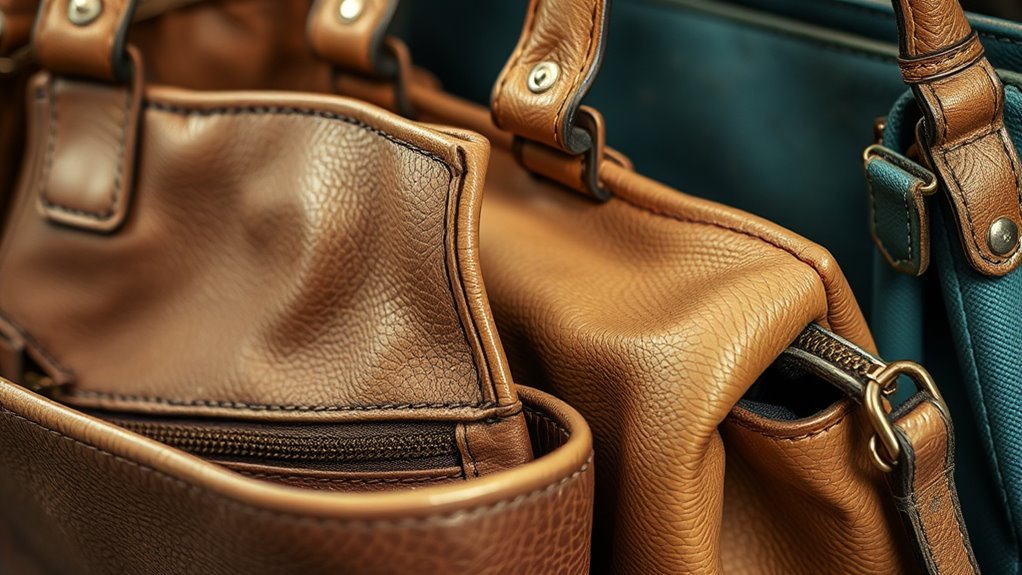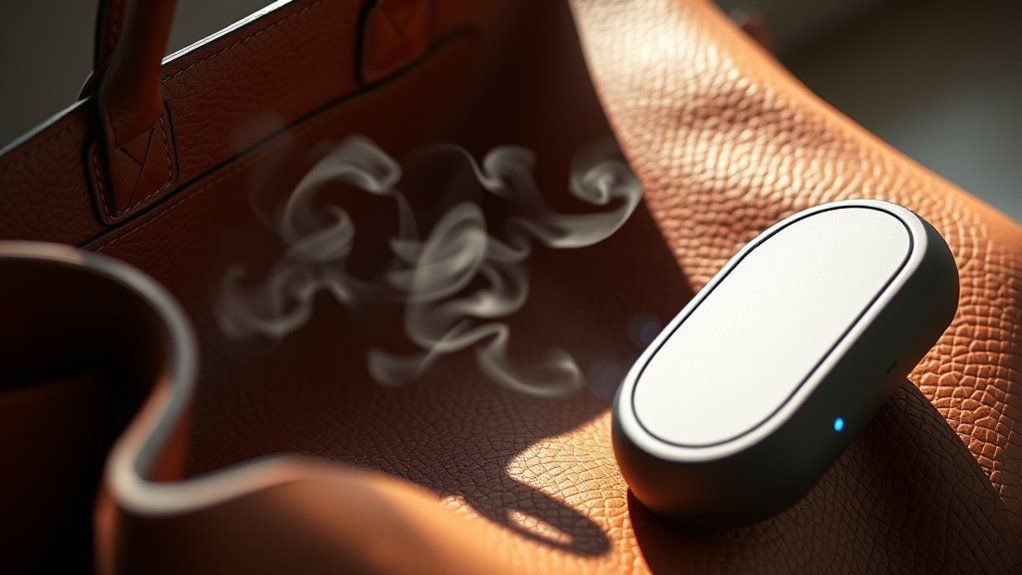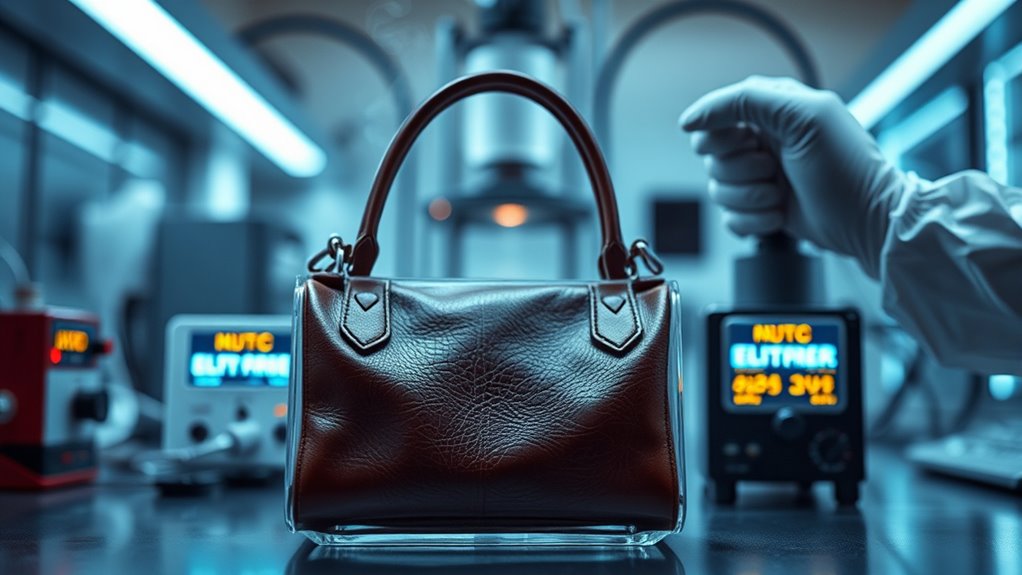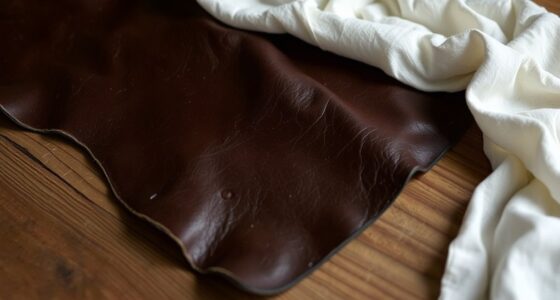Your sense of smell detects odors through molecules that bind to receptors in your nose, while fabrics trap these molecules using chemical bonds and porous fibers. To eliminate smells from secondhand bags, use odor-absorbing materials like activated charcoal or enzymes to break down odor-causing compounds. Proper cleaning, storage, and ventilation help keep your bag fresh. If odors persist, exploring professional options can guarantee a thorough refresh—discover more methods to keep your bag smelling new.
Key Takeaways
- Odor molecules bind to fibers in secondhand bags via chemical bonds, trapping scents deep within porous materials.
- Effective odor removal involves neutralizing or absorbing these molecules using activated charcoal, enzymes, or odor-neutralizing agents.
- Environmental factors like humidity and airflow influence how long odors persist in fabrics, affecting cleaning strategies.
- Proper ventilation, targeted cleaning, and odor-absorbing materials help accelerate odor dissipation and prevent lingering smells.
- Professional odor elimination techniques ensure thorough removal of embedded scents, especially for sensitive or valuable items.
How Our Sense of Smell Works

Your sense of smell begins when odor molecules enter your nose and bind to specialized receptors on sensory cells in the olfactory epithelium. This activates the olfaction pathway, transmitting signals from these receptors to your brain. When molecules bind, nerve signals travel along the olfactory nerve, reaching the olfactory bulb. From there, the information moves to various brain regions responsible for scent detection and interpretation. This process allows you to recognize and differentiate countless smells quickly. Your brain processes these signals, linking certain odors to memories or emotions. Because of this efficient olfaction pathway, you can detect subtle scent changes around you, whether it’s the aroma of coffee or the smell of a fabric. This intricate system makes your sense of smell both sensitive and crucial for everyday experiences.
Why Odors Linger in Fabrics and Materials

You might notice odors stick around in fabrics longer than expected. That’s because porous materials absorb scents and form strong chemical bonds that trap them inside. Environmental factors like humidity and airflow can also affect how long odors linger. Additionally, lingering odors can be affected by the material’s porosity, which determines how easily scents penetrate and are retained within the fabric.
Porous Material Absorption
Porous materials, such as fabrics and upholstery, tend to trap odors because their tiny fibers and gaps absorb airborne molecules through porous absorption. Material porosity allows these molecules to seep deep into the fibers, making odors difficult to remove. The small pores in fabrics act like sponges, soaking up smell particles from the environment or secondhand sources. This absorption process isn’t just surface-level; it penetrates into the fabric’s structure, causing odors to linger long after the initial source is gone. The more porous a material, the greater its capacity to hold onto smells. Additionally, material porosity influences how easily odors can be released during cleaning or airing out. Understanding this helps you see why fabrics and soft materials often require special cleaning methods to fully eliminate persistent odors. Porous absorption is key to why some smells are so stubborn in textiles.
Chemical Odor Bonds
Odors tend to linger in fabrics and materials because of the strong chemical bonds that form between odor molecules and fibers. These chemical bonds are like tiny hooks that trap odor molecules, making them harder to remove. When you smell a lingering odor, it’s often because these bonds hold the molecules tightly in place. Fabrics contain fibers with chemical structures that attract and hold onto odor molecules through various interactions, such as van der Waals forces or hydrogen bonds. Since these bonds are stable, they prevent odor molecules from easily escaping during normal cleaning. To effectively eliminate these odors, you need to break or weaken these chemical bonds. That’s why specialized cleaning methods or odor-neutralizing agents are often necessary to successfully remove stubborn smells from fabrics. Understanding the fiber structure of fabrics can help in choosing the most effective odor removal techniques.
Environmental Factors Influence
Environmental factors such as humidity, temperature, and airflow markedly affect how long odors stick around in fabrics and materials. High humidity, for example, amplifies odor retention by allowing molecules to bond more tightly with fibers, making odors harder to remove. Humidity effects are especially noticeable in urban pollution areas, where airborne pollutants settle into fabrics and trap unwanted smells. Warm temperatures can accelerate chemical reactions that cause odors to linger, while poor airflow prevents these molecules from dissipating. Conversely, good ventilation helps carry away odor particles, reducing their persistence. Understanding these environmental influences allows you to better manage and eliminate odors from secondhand bags and fabrics, especially in humid or polluted settings where odors tend to stick around longer. Moreover, the role of attention in the creative process demonstrates how focused effort can lead to innovative solutions for odor removal, such as designing effective cleaning methods or odor-neutralizing products.
Common Sources of Odors in Secondhand Bags

Secondhand bags often develop odors from a variety of sources, many of which you might not immediately notice. Over time, they can absorb smells that become trapped in the material. Common sources include:
- Pet odor, from fur, saliva, or accidents left behind.
- Mold smells, especially if stored in damp or humid environments.
- Food spills or lingering scents from previous owners.
- Sweat and body oils that seep into the fabric or lining.
These odors can be subtle but persistent, affecting your overall experience with the bag. Recognizing these sources helps you target specific cleaning methods to eliminate them effectively. Whether it’s pet odors or mold smells, understanding their origins is key to restoring your secondhand bag’s freshness.
Proper storage techniques can also help prevent odors from developing in the first place.
The Role of Odor Molecules and Their Persistence

Understanding how odor molecules behave helps explain why some smells stubbornly cling to your secondhand bag. Odor molecule interactions influence scent persistence; molecules with high stability resist breakdown, making odors linger longer. These molecules form bonds with fabric fibers, trapping scent compounds and resisting evaporation. Your bag’s material affects this process, as certain fibers facilitate stronger interactions, prolonging odor presence. Consider the table below to see how different factors impact odor molecule stability:
| Factor | Effect on Odor Molecules | Result |
|---|---|---|
| Material Type | Stronger interactions with synthetic fibers | Odors last longer |
| Molecule Size | Larger molecules have higher scent stability | More persistent odors |
| Environmental Conditions | Increased humidity enhances odor retention | Odor molecules cling more |
Additionally, understanding IRA Inheritance Rules helps in planning how to manage assets that may be affected by lingering odors, especially if property is inherited or part of estate planning.
Scientific Techniques for Eliminating Odors

When it comes to eliminating odors, you can use methods like absorbing odor molecules with materials such as activated charcoal. Neutralizing smells with enzymes breaks down odor-causing compounds at their source. Additionally, odor-absorbing materials trap or neutralize smells, leaving your space fresher. For a more comprehensive approach, consider dog quotes for reflection and humor which can help keep a positive mindset during the cleaning process.
Absorbing Odor Molecules
To effectively eliminate odors, scientists develop materials and techniques that absorb odor molecules directly from the air. These methods trap molecules before they reach your nose, reducing persistent smells. One approach involves using activated charcoal or zeolites, which attract and hold odor particles. Additionally, incorporating fragrance masking agents can temporarily hide odors while absorption occurs. Controlling microbial growth on surfaces also plays a key role, as bacteria can produce odors over time. Techniques include:
- Using porous materials like charcoal filters to absorb volatile molecules
- Applying chemical absorbents that bind odor molecules chemically
- Combining absorption with fragrance masking for immediate odor concealment
- Implementing antimicrobial coatings to prevent microbial growth and odor formation
- Employing air purification technologies that target odor molecules at a molecular level
These strategies work together to keep secondhand bags smelling fresh, addressing odor at its source.
Neutralization With Enzymes
Building on odor absorption techniques, enzymes offer a powerful way to neutralize smells at their source. Enzyme neutralization works through odor enzyme action, where specific enzymes break down odor-causing molecules into harmless substances. When you apply enzyme-based cleaners, the enzymes target organic compounds responsible for unpleasant smells, effectively destroying them rather than masking the odor. This process is especially effective for organic stains and odors from food, sweat, or pet residues. Unlike chemical deodorants that temporarily cover up smells, enzyme neutralization provides a lasting solution by eliminating the root cause. To maximize results, guarantee the enzyme product is in contact with the odor source for a sufficient amount of time, allowing the enzymes to fully break down the odor molecules. Incorporating enzyme treatments can also support overall mental clarity by reducing persistent odors that may contribute to discomfort or distraction.
Odor-Absorbing Materials
Odor-absorbing materials work by capturing and holding odor molecules, preventing them from reaching your sense of smell. Activated charcoal is a top choice because of its porous structure, which traps molecules effectively. Odor neutralizers also play a role by chemically transforming odors into harmless substances. To maximize odor removal, consider these techniques:
- Use activated charcoal sachets inside your bag for continuous absorption.
- Incorporate odor-neutralizing sprays that contain natural enzymes.
- Place baking soda at the bottom of your bag to absorb lingering smells.
- Clean the interior regularly with a gentle, odor-neutralizing wipe or cloth.
- Implementing automation technologies can help monitor and maintain fresh scents in your belongings.
Practical Tips for Freshening Up Your Bag

If your bag starts to develop an unpleasant smell, there are simple steps you can take to refresh it quickly. One effective method is scent masking, which involves adding a pleasant fragrance to cover up odors. You can create a DIY spray using water, a few drops of essential oil, and a spray bottle. Lightly mist the interior and exterior of your bag, focusing on areas that trap odors. Make sure not to oversaturate to avoid damage. Additionally, placing odor-absorbing materials like activated charcoal or baking soda inside your bag overnight can help eliminate stubborn smells. For a quick fix, you might also keep a scented sachet or dryer sheet inside your bag when not in use. These simple tips can keep your bag smelling fresh without much effort.
When to Seek Professional Odor Removal Services

While simple remedies can often handle minor odors in your bag, some smells persist despite your best efforts. When odors become stubborn, it’s time to contemplate professional intervention for effective odor removal. You should seek professional odor removal services if:
- The smell lingers after multiple home treatments
- The odor seems embedded in the material
- You notice a strong, unpleasant odor that worsens over time
- You’re dealing with sensitive or valuable items that require careful handling
Professional intervention uses specialized techniques and equipment to target stubborn odor removal. If your bag’s smell refuses to fade despite your efforts, consulting odor removal experts ensures thorough elimination and preserves your bag’s condition. Don’t let persistent odors compromise your bag’s freshness.
Frequently Asked Questions
Can Certain Scents Actually Worsen Bag Odors?
Yes, certain scents can worsen bag odors. When you use fragrance masking or scent layering, you might temporarily hide the smell, but it often combines with the existing odor, creating a more complex or stronger scent. Instead of improving the smell, this can make the bag smell worse over time. To truly eliminate odors, focus on cleaning and deodorizing rather than relying solely on adding scented products.
How Long Does It Typically Take to Eliminate Persistent Odors?
When addressing how long it takes to eliminate persistent odors, it varies based on the bag’s odor absorption and scent retention. Typically, you’ll notice improvement within a few days to a week with regular cleaning and airing out. For stubborn smells, using odor absorbers like baking soda or charcoal can speed up the process, but deep-seated scent retention may take longer, sometimes up to two weeks, depending on the severity of the odor.
Are Some Materials More Resistant to Odor Removal Than Others?
Some materials resist odor removal more than others, testing your patience and persistence. Durable materials like leather or synthetic fibers often have high material durability but can absorb odors deeply, making odor absorption stubborn. Conversely, fabrics like canvas or nylon may be easier to deodorize but still challenge you if odors penetrate their fibers. Understanding how different materials interact with odors helps you choose the right cleaning methods, easing your journey toward freshness.
What Natural Remedies Are Most Effective for Odor Elimination?
You can try natural remedies like herbal infusions and baking soda to eliminate odors. Herbal infusions, such as lavender or chamomile, can absorb and mask unwanted smells, while baking soda effectively neutralizes odors by absorbing moisture and odor particles. Simply sprinkle baking soda inside your bag or use herbal sachets, then let them sit for a few hours or overnight. These natural options are safe, affordable, and eco-friendly solutions for freshening your secondhand bag.
Does Exposure to Sunlight Help Remove Odors From Secondhand Bags?
Sunlight exposure can help remove odors from secondhand bags by harnessing UV rays that act as natural fabric bleaching agents. When you leave your bag in direct sunlight, the UV light helps break down odor molecules, reducing smells. Plus, sunlight’s natural fabric bleaching can help eliminate stains and refresh your bag’s appearance. Just be cautious with delicate materials, as too much sun exposure might cause fading or damage.
Conclusion
Understanding how your sense of smell works and the science behind lingering odors can help you keep your secondhand bags fresh. Did you know that odors can persist in fabrics for weeks if not properly treated? By using scientific techniques and practical tips, you can effectively eliminate unwanted smells and enjoy your bags anew. When odors stubbornly remain, don’t hesitate to seek professional help—keeping your accessories smelling clean has never been easier.









